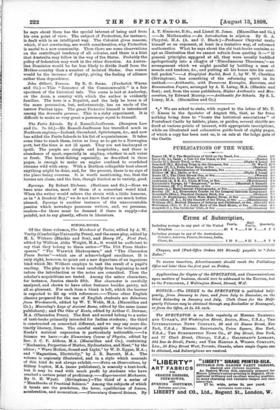SCHOOL-BOOKS.
Of the three volumes, The Merchant of Venice, edited by A. W. Verity (Cambridge University Press), and the same play, edited by H. L. Withers (Blackie and Son), and Henry IV., First Part, edited by William Aldis Wright, M.A., it would be sufficient to say that they belong to three series—" The Pitt Press Shake- speare," " The Warwick Shakespeare," and " The Clarendon Press Series"—which are of acknowledged excellence. It is only right, however, to point out a new departure of an ingenious kind which Mr. Withers employs to test the result of a pupil's reading. The play is to be read carefully from beginning to end before the introduction or the notes are consulted. Then the scholar's acquisitions are tested. Among the minor characters, for instance, Jessica stands fifth. Her character is carefully analysed, and shown to have other features besides gaiety, not all so pleasant. For each item a blank is left, which the learner is expected to fill up with references.—Three other English classics prepared for the use of English students are Selections from Wordsworth, edited by W. T. Webb, M.A. (Macmillan and Co.) ; Macaulay's Lays of Ancient Rome, edited by the same (same publishers) ; and The Odes of Keats, edited by Arthur C. Downer, M.A. (Clarendon Press). The first and second belong to a series of text-books primarily intended for Indian students; the third is constructed on somewhat different, and we may say more dis- tinctly literary, lines. The careful analysis of the technique of Keats's metrical expression is particularly noticeable.—In Science we have :—An Elementary Course of Physics, edited by Rev. J. C. P. Aldous, M.A. (Macmillan and Co.), containing " Mechanics, Properties of Matter, Hydrostatics, and Heat," by the editor; " Wave Motion, Sound and Light," by W. D. Egger, M.A. ; and " Magnetism, Electricity," by J. R. Barrett, M.A. The volume is copiously illustrated, and in a style which manuals of this kind do not always exhibit. —Notes on Observations, by Sidney Lupton, M.A. (same publishers), is scarcely a text-book, but it may be read with much profit by students who have reached a certain point of proficiency.—Experimental Mechanics. By G. H. Wyatt. (Rivingtons.)—The third of a series of " Handbooks of Practical Science." Among the subjects of which it treats are the pendulum, the lever, equilibrium of forces, acceleration, and momentum.—Elementary General Science. By A. T. Simmons, B.Sc., and Lionel M. Jones. (Macmillan and Co.) —In Mathematics :—An Introduction to Algebra. By G. A. Chrystal, M.A. (A. and C. Black.)—Professor Chrystal ranks himself as an exponent, at least in a tentative way, of reformed mathematics. What he says about the old text-books contains so apt au illustration that we cannot refrain from quoting it :—" If general eippkred at all, they were usually huddled apologetically into a chteeter of 'Miscellaneous Theorems,'—an arrangement which we might parallel by building a man of muscle and tendons, &c., and putting all his bones into his coat- tail pocket."—A Simplified Euclid, Book I., by W. W. Cheriton (Rivingtons), has something of the reforming spirit in its method.—Arithmetic, with Numerous Examples, Exercises, and Examination Papers, arranged by A. E. Laing, M.A. (Blackie and Son); and, from the same publishers, Higher Arithmetic and Men- suration, by Edward Murray.—Arithmetic for Schools. By S. L. Loney, M.A. (Macmillan and Co.)


































 Previous page
Previous page